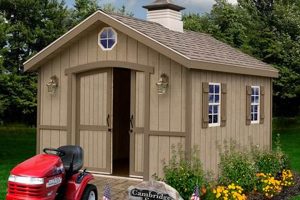Constructions utilizing reclaimed shipping platforms for creative and functional purposes represent a significant trend in resourcefulness and sustainable living. These undertakings range from simple home dcor enhancements to more complex furniture creation, all relying on the readily available and often inexpensive nature of the source material. For instance, a basic coffee table can be assembled from a single platform, while deconstructed elements can form vertical gardens or wall paneling.
The appeal of these ventures lies in their contribution to waste reduction and the potential for cost savings, offering an environmentally conscious alternative to purchasing new goods. Historically, adapting existing materials for alternative uses has been a practice born of necessity, yet it has evolved into a movement that celebrates ingenuity and personal expression. Furthermore, these practices foster a sense of self-sufficiency and promote a tangible connection to the creation process.
The subsequent discussion will delve into the practical aspects of sourcing appropriate materials, essential safety precautions to observe, and a selection of specific construction ideas suitable for various skill levels. This information aims to equip individuals with the knowledge necessary to confidently embark on their own resourceful builds and contribute to a more sustainable approach to home improvement and dcor.
Essential Considerations for Pallet-Based Construction
Prioritizing safety and material selection are critical before commencing any construction. The following points outline essential factors for a successful and secure building experience.
Tip 1: Source Identification: Examine the pallet for an IPPC stamp. This mark indicates treatment methods. Avoid pallets marked with “MB” (methyl bromide) due to its toxicity. Prefer those marked “HT” (heat treated), which are generally safer.
Tip 2: Safety Gear: Always wear safety glasses, gloves, and a dust mask when handling and cutting. The wood can contain splinters, and sanding generates fine particles.
Tip 3: Material Inspection: Carefully inspect for damage, such as cracks, rot, or insect infestation. Discard any compromised pallets to maintain the integrity of the final piece.
Tip 4: Proper Disassembly: Employ appropriate tools like a pry bar, hammer, and reciprocating saw for disassembly. Exercise caution to avoid injury and wood splitting.
Tip 5: Thorough Cleaning: Clean the wood with soap and water, and consider using a bleach solution to disinfect. Allow the material to dry completely before further processing.
Tip 6: Sanding and Finishing: Sanding is crucial to remove rough edges and create a smooth surface. Apply a sealant or finish to protect the wood and enhance its appearance.
Tip 7: Joint Reinforcement: Employ wood glue and screws or nails for strong and durable joints. Consider using metal brackets for added stability in weight-bearing structures.
By adhering to these principles, projects can be safely and effectively executed, ensuring longevity and aesthetic appeal. Prioritizing these guidelines contributes to responsible and sustainable crafting.
The subsequent sections will explore specific design ideas, allowing for the practical application of these considerations and further refinement of crafting skills.
1. Sourcing
The initial phase of any venture involving reclaimed shipping platforms lies in securing appropriate raw materials. The sourcing process dictates project feasibility and long-term success.
- IPPC Stamp Identification
This mark indicates treatment methods. Pallets stamped “MB” denote methyl bromide fumigation, a toxic chemical. Avoid these. “HT” (heat treated) are a safer alternative. The presence and type of IPPC stamp critically influence material safety.
- Material Condition Assessment
Thoroughly inspect each platform for signs of damage. Cracks, rot, mold, or insect infestation compromise structural integrity. Discard compromised materials to ensure project stability and prevent further deterioration.
- Supplier Reliability
Establish reliable sources. Local businesses, construction sites, and recycling centers are potential suppliers. Inquire about the platform’s previous contents; those used to transport chemicals or hazardous materials are unsuitable.
- Cost vs. Effort Analysis
Consider the cost of acquiring free pallets versus the effort required for sourcing, transportation, and preparation. Paid sources may offer better quality control, saving time and labor in the long run.
Effective sourcing maximizes project potential, mitigates safety risks, and contributes to the sustainability goals inherent in repurposing used shipping platforms. Proper diligence in this phase establishes the foundation for successful craftsmanship.
2. Disassembly
The process of disassembly is a critical precursor to many constructions involving reclaimed shipping platforms. Proper deconstruction enables the transformation of a rigid, standardized structure into usable components for diverse applications. Ineffective disassembly can result in damaged wood, posing safety risks and reducing material yield. Consider the simple example of a pallet intended to become a headboard: haphazard dismantling may yield splintered, uneven planks, whereas careful separation along existing joinery lines preserves the wood’s integrity and minimizes waste, directly affecting the aesthetic and structural quality of the final headboard.
Specific tools and techniques are essential for efficient and safe disassembly. A reciprocating saw, pry bar, and hammer are common implements, each requiring careful application to avoid splitting or cracking the wood. For example, attempting to force planks apart without using a pry bar typically leads to breakage. Furthermore, the presence of nails or screws necessitates cautious extraction; neglecting to remove these fasteners can damage cutting tools in subsequent processing stages. The level of care and skill exhibited during disassembly directly influences the quantity and quality of usable material available for the intended project.
In summary, disassembly represents a pivotal phase in the repurposing process. Mastery of appropriate techniques minimizes material loss, enhances safety, and ultimately determines the feasibility and quality of subsequent constructions. A thorough understanding of this stage is therefore indispensable for individuals seeking to engage in resourceful constructions utilizing reclaimed shipping platforms.
3. Safety
Working with reclaimed shipping platforms necessitates a strong emphasis on safety protocols to mitigate potential risks. The inherent nature of used platforms presents various hazards, ranging from chemical contamination to structural instability. A failure to address these dangers can lead to injury, illness, or project failure. For example, inhaling sawdust from chemically treated wood can result in respiratory problems, while using a structurally unsound platform for furniture construction can lead to collapse and potential harm. Safety, therefore, is not merely an ancillary consideration but a fundamental component of successful and responsible construction.
Specific safety measures include wearing appropriate personal protective equipment (PPE), such as safety glasses, gloves, and respirators. Proper tool handling and maintenance are also essential; blunt or improperly used tools increase the risk of accidents. Furthermore, knowledge of wood identification and treatment methods is crucial to avoid using platforms treated with harmful substances. Thorough inspection of the wood for nails, staples, or splinters prior to handling reduces the risk of cuts and punctures. These actions are imperative to ensure well-being throughout the construction process.
In conclusion, prioritizing safety is paramount in constructions involving reclaimed shipping platforms. Adherence to established safety guidelines minimizes the risk of injury and exposure to hazardous materials. A commitment to safety not only protects the individual but also promotes responsible resource utilization and project longevity. Ignoring these considerations can have severe consequences, undermining the intended benefits of the project.
4. Design
The design phase within the context of construction using reclaimed shipping platforms represents a critical juncture where creativity converges with structural and functional requirements. This phase dictates the ultimate utility and aesthetic appeal of the finished product. Careful planning and consideration of various design elements are essential for successful outcomes.
- Functionality Integration
Design must prioritize the intended purpose of the constructed item. Whether a simple coffee table or a complex shelving unit, the design should optimize usability and meet specific user needs. For example, a design for outdoor seating must consider weather resistance and comfort, while a design for storage solutions requires efficient space utilization.
- Aesthetic Considerations
Visual appeal is a significant design factor. The natural characteristics of the reclaimed wood, such as grain patterns and weathering, can be incorporated into the design to create a unique aesthetic. Furthermore, surface treatments, such as staining or painting, can enhance the visual impact and complement the overall design scheme.
- Structural Integrity
A well-conceived design accounts for the structural limitations of the material. The design should ensure stability and load-bearing capacity appropriate for the intended use. Reinforcements, such as metal brackets or additional support beams, may be necessary to enhance structural integrity and prevent failure.
- Material Optimization
Design decisions should optimize the use of available materials. Efficient layouts and cutting plans minimize waste and maximize the number of components that can be extracted from each platform. This approach not only reduces costs but also contributes to the sustainability goals inherent in repurposing used shipping platforms.
The multifaceted nature of design, when applied to projects utilizing reclaimed shipping platforms, requires a holistic approach that integrates functionality, aesthetics, structural integrity, and material optimization. Thoughtful design choices lead to creations that are not only visually appealing but also durable, functional, and environmentally responsible, thereby maximizing the inherent potential of the repurposed material.
5. Finishing
The finishing stage in constructions involving reclaimed shipping platforms is intrinsically linked to the project’s overall success, influencing both aesthetics and longevity. Untreated wood from such platforms is susceptible to moisture damage, insect infestation, and general wear and tear. The act of finishing, therefore, transforms a raw, potentially unstable material into a durable and visually appealing end product. For example, a pallet-derived outdoor bench left unfinished will quickly degrade due to weather exposure, while a properly sealed and stained bench can withstand the elements for several seasons.
Specific finishing techniques, such as sanding, sealing, staining, and painting, each contribute unique benefits. Sanding smooths rough surfaces, removing splinters and creating a more tactile experience. Sealants protect the wood from moisture absorption, preventing warping and rot. Stains enhance the natural grain patterns and add color, while paint provides a protective layer and allows for greater customization. Consider a shelving unit constructed from pallets: sanding ensures books slide easily without snagging, while a coat of varnish protects against spills and stains, demonstrating the practical application of these techniques.
In conclusion, the finishing process is not merely an aesthetic afterthought but a critical step that directly impacts the lifespan and functionality of any construction using reclaimed shipping platforms. It addresses the inherent vulnerabilities of the raw material, providing protection and enhancing visual appeal. Neglecting this stage significantly diminishes the project’s long-term value and increases the likelihood of premature failure, underscoring its fundamental importance.
Frequently Asked Questions
The subsequent section addresses common inquiries regarding projects utilizing reclaimed shipping platforms, providing clarification on prevalent concerns and misconceptions.
Question 1: How does one identify shipping platforms safe for repurposing?
The presence of an IPPC stamp is crucial. Platforms marked “MB” should be avoided due to methyl bromide fumigation. “HT” (heat treated) platforms are generally safer. Assessing overall condition for structural integrity is also essential.
Question 2: What safety precautions are necessary when working with these materials?
Safety glasses, gloves, and a dust mask are indispensable. Thorough cleaning and inspection for nails or splinters are mandatory. Adequate ventilation is required during sanding or cutting operations.
Question 3: How should reclaimed shipping platforms be disassembled?
A reciprocating saw, pry bar, and hammer are common tools. Exercise caution to avoid splitting the wood. Nails and screws should be removed carefully to prevent damage to cutting tools in subsequent stages.
Question 4: Are all types of wood equally suitable for construction?
Different wood species possess varying strengths and durability. Softer woods may be suitable for decorative elements, while hardwoods are preferable for load-bearing structures. Knowledge of wood properties is advantageous.
Question 5: What are the recommended finishing techniques for these projects?
Sanding is critical to create a smooth surface. Sealants protect against moisture, while stains and paints enhance aesthetics. The selection of finishing products should align with the intended use and environmental conditions.
Question 6: How can the lifespan of constructions utilizing reclaimed shipping platforms be extended?
Proper construction techniques, appropriate wood selection, and regular maintenance are vital. Periodic inspections and repairs can address minor issues before they escalate. Protection from the elements is also essential.
These answers provide a foundational understanding for individuals contemplating construction using reclaimed shipping platforms. Adherence to these guidelines promotes both safety and project success.
The following section will delve into advanced techniques and elaborate on complex designs for those seeking to expand their skills and expertise.
Conclusion
The exploration of “diy projects with wooden pallets” has revealed the multifaceted nature of this endeavor, encompassing considerations ranging from safety and material selection to design and finishing. The successful execution of such projects demands adherence to established guidelines and a thorough understanding of the inherent properties of the reclaimed materials.
The integration of ingenuity and responsible resource management allows for the transformation of discarded materials into functional and aesthetically pleasing objects. This practice offers a pathway toward sustainable living and encourages a mindful approach to consumption, suggesting a future where resourcefulness and environmental consciousness converge to shape innovative solutions.







